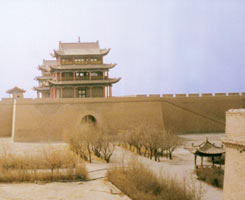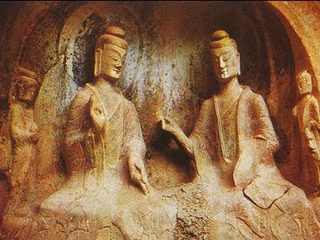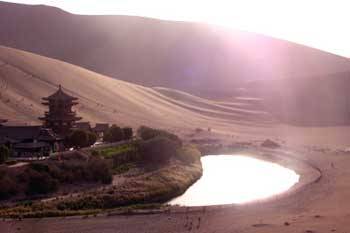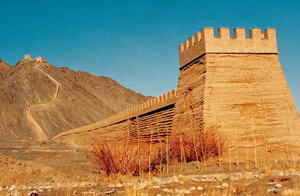Jiayuguan Pass

Jiayuguan Pass is the first pass at the west end of the Great Wall of China and was built during the Ming Dynasty. It is the western terminal of the world famous Great Wall as well as the third biggest gliding bade in the world.
The pass is located at the narrowest point of the western section of the Hexi Corridor, 6 kilometers southwest of the city of Jiayuguan in Gansu. The structure lies between two hills, one of which is called Jiayuguan Hill. It was built near an oasis that was then on the extreme western edge of China.
The pass is trapezoid-shaped with a perimeter of 733 meters and an area of more than 33,500 square meters. The total length of the city wall is 733 meters and the height is 11 meters.
There are two gates: one on the east side of the pass, and the other on the west side. On each gate there is a building. An inscription of "Jiayuguan" in Chinese is written on a tablet at the building at the west gate. The south and north sides of the pass are connected to the Great Wall. There is a turret on each corner of the pass. On the north side, inside the two gates, there are wio;hi9pide roads leading to the top of the pass.
Jiayuguan consists of three defense lines: an inner city, an outer city and a moat. The structure was initially built during the early Ming dynasty, sometime around the year 1372.
According to legend, when Jiayuguan was being planned, the official in charge asked the designer to estimate the exact number of bricks required and the designer gave him a number. The official questioned his judgment, asking him if that would be enough, so the designer added one brick. When Jiayuguan was finished, there was one brick left over, which was placed loose on one of the gates where it remains today.
The Jiayuguan Pass was a key waypoint of the ancient Silk Road. Jiayuguan has a somewhat fearsome reputation because Chinese people who were banished were ordered to leave through Jiayuguan for the west, never to return.
Around Jiayuguan there are many historic sites such as the Mogao Grottoes. The Mogao Grottoes is 3 hours drive from Jiayuguan Pass. Many frescos were found in the areas around Jiayuguan.
Different sections of Great Wall
Badaling Great Wall
Mutianyu Great Wall
Huangyaguan Great Wall
Jinshanling Great Wall
Simatai Great Wall
Juyongguan Great Wall
Jiayuguan Great Wall
Overhanging Great Wall
The Great Wall was built with dirt, stone and bricks. At the top of the Great wall, a roadway paved with three layers of brick connected the watchtowers. The roadways are wide enough to hold ten soldiers side by side. Trekking on Great Wall offers an interesting climb and great views, it can be quite exhausting to reach the top. Nevertheless, if possible, try to avoid going on a national holiday or at the weekend.





